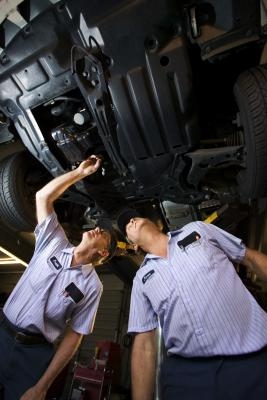
Fuel lines are tubes that carry gasoline from gas tanks to engine of your car. They have two sections. The first leads from the gas tank to the fuel filter and fuel pump. The filter screens out dirt, rust and other debris that could harm a vehicle's engine. The second section leads from the fuel pump to the engine. Fuel line repair kits come with parts that fit General Motors, Ford, Chrysler, as well as adapter parts for foreign car models. GM fuel lines are made of out nylon tubes. When the fuel lines leak, the tubes need to be replaced.
Place your vehicle on the ramp stand or jack it up near the passenger rear tire to raise it up enough to work under.
Remove the fuel filter. Remove the gas cap in order to relieve any pressure that may be in the fuel lines. Take a 7-mm socket wrench and remove the bracket that holds the fuel filter in place. Pull the filter down a bit so that you can reach the clips. Press the button at the end of the clip and pull the filter out. Set the filter aside in a safe place.
Take out the passenger side rear seat. Pull back on the felt covering of the seat's base to reveal the opening to the fuel pump, which is a black circle that looks like a paint can lid. Remove the three screws and take off the panel.
Disconnect the fuel line, which is a black nylon hose with attachment. Tie a string around the fuel line connector so that you can pull it back up later to reinstall it. Move the fuel line connector under the panel and pull it so that it has slack under the car.
Put the old and new fuel lines together, cutting the new line to match the old one's length.
Place a pot on your stove and fill it with water. Bring the water to a boil. Remove the fuel line connector from the white plastic end piece. Place the end of the fuel line or the fuel line connector into the boiling water for ten minutes to soften it up. Remove the fuel line connector with a pair of tongs. This is done to ensure that the new connection makes a good seal and won't leak.
While the connector is still soft and warm, slide it back onto the white plastic end piece. Place the metal ring onto the end of the fuel line connector. Apply even pressure onto the ring with a pair of pliers to clamp it shut.
Cut the nylon fuel line from under the car, just after the damage point. Soak the line in boiling water for up to ten minutes by holding a pot of hot water up under the car to submerse the tip of the vehicle fuel line. Insert the union fully into the line and re-attach all of the fittings.
Insert the fuel filter and then snap the connectors in place. Use the string to pull the fuel line back up into the car's interior and attach the connector onto the fuel pump. Put the seat back.
Check to make sure that the fuel filter has been installed correctly, then slide the clamp around it and shut it to secure it in place. Turn the engine on and check for leaks.